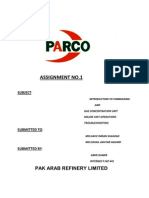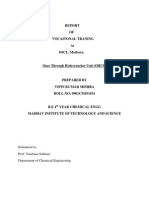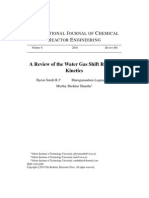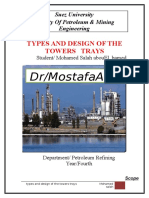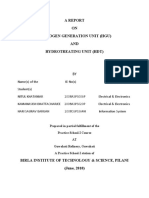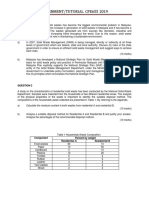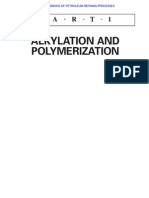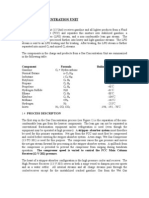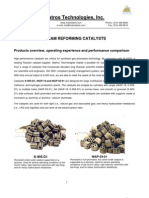Nptel Lecture Notes 2
Uploaded by
balusappsNptel Lecture Notes 2
Uploaded by
balusappsNPTEL Chemical Engineering Chemical Engineering Design - II
Module # 2
MECHANICAL DESIGN OF HEAT EXCHANGER: MECHANICAL DESIGN OF SHELL AND TUBE
HEAT EXCHANGER
1.
2.
MECHANICAL DESIGN STANDARDS OF SHELL AND TUBE HEAT
EXCHANGERS
DESIGN CONSIDERATIONS
2.1.
Design pressure and temperature
2.2.
Materials of construction
2.3
Design components
2.3.1. Shell diameter and thickness
2.3.2.
Shell cover
2.3.3. Channel covers diameter and thickness
2.3.4. Pass partition plate
2.3.5 . Tube sheet thickness
2.3.6. Impingement plates or baffles
2.3.7. Nozzles and branch pipes
2.3.8.
Gaskets
2.3.9. Bolts design
2.3.10. Design of flange
2.3.11. Design of supports
3.
SOLVED EXAMPLE
Joint initiative of IITs and IISc Funded by MHRD
Page 1 of 21
NPTEL Chemical Engineering Chemical Engineering Design - II
Lecture 1: Mechanical Design Standards
1.
MECHANICAL DESIGN STANDARDS OF SHELL
AND TUBE HEAT EXCHANGERS
Mechanical design of heat exchangers includes design of various pressure and nonpressure parts. The structural rigidity and satisfactory service of heat exchangers depends
on the appropriate mechanical design. Mechanical design is generally performed
according to the design standardsand codes. Some mechanical design standards used in
heat exchanger design are: TEMA (United States), IS:4503-1967 (India);BS: 3274
(United Kingdom) and BS: 20414 (United Kingdom). The design structure of IS: 45031967 is provided in Table 2.1 [1].
Most countries of the world follow the TEMA (Tubular Exchanger Manufacturers
Association) standards for the mechanical design of unfired shell and tube heat
exchangers. The TEMA standards are applicable for the maximum shell ID and wall
thickness of 60 and 2 inch, a maximum design pressure of 3000 psi and a maximum
nominal diameter (inch) design pressure (psi) of 60000 lb/in, respectively[2].
Three basic classes of TEMA standards are: C, B and R.
-
The class C specifies the standards for general service exchangers.
The class B specifies the standards of heat exchangers for chemical services.
The class R specifies the standards of heat exchangers for more severe
application in petroleum and related processes.
Seven types of shells are standardized by the TEMA. The TEMA standards also specify
the types of front-end, shell, and rear-end of shell and tube exchangers as shown in
Figure 2.1. For example, a fixed tube-sheet type BEM exchanger is illustrated in
Figure1. 2 of module #1.
Joint initiative of IITs and IISc Funded by MHRD
Page 2 of 21
NPTEL Chemical Engineering Chemical Engineering Design - II
Table 2.1. Structure of IS: 4503-1967[1].
Part 1
Part 2
Part 3
Part 4
Part 5
Part 6
Part 7
Part 8
Part 9
Part 10
Part 11
Part 12
Scope
Types and nomenclature
Terminology
Classification and permitted pressures
Material of constructions
Design stress
General design
Corrosion and corrosion allowance
Shells
Tubes
Tube sheet
Shell covers
Joint initiative of IITs and IISc Funded by MHRD
Part 13
Part 14
Part 15
Part 16
Part 17
Part 18
Part 19
Part 20
Part 21
Part 22
Part 23
Part 24
Baffles and support plates
Floating heads
Channels and channel covers
Nozzles and branch pipes
Gaskets and gland packings
Flanges
Supports
Inspection
Testing
Marking
Preparation for dispatch
Certificates of compliance
Page 3 of 21
NPTEL Chemical Engineering Chemical Engineering Design - II
Figure 2.1. Types of shells, front end and rear ends (TEMA classifications) [3].
Joint initiative of IITs and IISc Funded by MHRD
Page 4 of 21
NPTEL Chemical Engineering Chemical Engineering Design - II
2.
DESIGN CONSIDERATIONS
2.1.
Design pressure and temperature
Design pressure of a heat exchanger is the gage pressure at the top of the vessel. This
pressure is used to determine the minimum wall thickness of the various pressure parts.
The IS: 4503 species that the design pressure should at least 5% greater than the
maximum allowable working pressure. Usually a 10% higher value is used. The
maximum allowable working pressure is the gage pressure for a specified operating
temperature that is permitted for the service of the exchanger units. According the IS:
4503, the shell and tube sides pressure should be specified individually. The design
pressure specification is at 250, 120 and 65C for carbon steel, stainless steel and nonferrous metals respectively. The maximum permissible stresses for various heat
exchanger components should not be exceeded at the allowable pressure.
The design temperature is used to determine the minimum wall thickness of various parts
of the exchanger for a specified design pressure. It is normally 10C greater than the
maximum allowable temperature.
Joint initiative of IITs and IISc Funded by MHRD
Page 5 of 21
NPTEL Chemical Engineering Chemical Engineering Design - II
2.2.
Materials of construction
All materials used construction of shell and heat exchangers for pressure parts must have
the appropriate specification as given in IS: 4503 Appendix C. The materials of
construction should becompatible with process fluids and others parts of materials and
also should be cost effective. The maximum permitted operating fluid temperatures
should not exceeds for the various pressure-retaining components as specified by IS:4503
given inTable 2.2 [1].High chrome-Mo-Ni alloys (Cr content 12-27%)can be used for
high temperature services upto 2100C. Useof any carbon or low alloy steel is not
recommended for the construction of heat exchangers forthe service below 0C.
Table 2.2. Materials of constructions [1].
Materials of construction
Carbon steel
C-Mo steel
Cr-Mo steel
Low alloy steel (< 6 % Cr)
Alloy steel (<17 % Cr)
Austenitic Cr-Ni steel
Cast iron
Brass
Joint initiative of IITs and IISc Funded by MHRD
Allowable fluid temperature, C (F)
540 (1004)
590 (1094)
650 (1202)
590 (1094)
590 (1094)
650 (1202)
200 (392)
200 (392)
Page 6 of 21
NPTEL Chemical Engineering Chemical Engineering Design - II
Lecture 2: Design Components
2.3
Design components
The major mechanical design components of shell and tube heat exchangers are: shell
andtube-sheet thickness, shell cover, flanges, nozzles, gaskets, stress calculations and
design of supports.
2.3.1. Shell diameter and thickness
The nominal diameter (outside diameter in millimeters rounded is to the nearest integer)
of the heat exchanger is specified inIS: 2844-1964 in case of shells manufactured from
flat sheet. The following diameters (in mm) should be preferably used in the case of
cylindrical pipe shell: 159, 219, 267, 324, 368, 419, 457, 508, 558.8, 609.6, 660.4,
711.2,762, 812.8, 863.6, 914.4 and 1016.
The shell thickness ( ) can be calculated from the equation below based on the
maximum allowable stress and corrected for joint efficiency [2]:
= 0.6
+
(2.1)
=shell thickness
= design pressure
= Shell ID
=Maximum allowable stress of the material of construction
=Joint efficiency (usually varies from 0.7 to 0.9)
The minimum shell thicknesses should be decided in compliance with the nominal shell
diameter including the corrosion allowance as specified by IS: 4503. Usually the
minimum shell thicknesses are in order for various materials for the same service:Cast
iron> Carbon steel Al and Al-alloys (up to 700C)> Cu and Cu-alloys Ni
Austenitic stainless steel= Monel inconel.
Joint initiative of IITs and IISc Funded by MHRD
Page 7 of 21
NPTEL Chemical Engineering Chemical Engineering Design - II
2.3.2. Shell cover
There are different types shell covers used in shell and tube heat exchangers: flat,
torispherical, hemispherical, conical and ellipsoidal. Out of various types of head covers,
torispherical head is the most widely used in chemical industries for operating pressure
up to 200psi.The thickness of formed head is smaller than the flat for the same service
[2].Accordingthe IS: 4503, the minimum thickness of the shell cover should be at least
equal to the thickness of the shell.
The required thickness of a torispherical head ( ) can be determined by:
th
pRiW
c
(2 fJ 0.2 p )
(2.2)
1
R
W 3 i
4
ri
(2.3)
= Crown radius, =Knucle radius, =corrosion allowance
2.3.3. Channel coversdiameter and thickness
The outside diameter of the channel shall be the same as that of the shell. The thickness
of the channel shall be greater of the two values: (i) shell thickness or (ii) thickness
calculated on the basis of the design shown below pressure.
The effective channel cover thickness ( in mm) is calculated from the formula (IS:4503
section 15.6.1)[1]:
= 10
(2.4)
= diameter of the cover [mm] usually same as the outside shell diameter
1 = a factor which is 0.25 when the cover is bolted with fullfaced gaskets and 0.3 when
bolted with narrow faced or ring type gaskets
= design pressure in kgf/cm2and
= allowable stress value in kgf/mm2 at design temperature
Joint initiative of IITs and IISc Funded by MHRD
Page 8 of 21
NPTEL Chemical Engineering Chemical Engineering Design - II
2.3.4. Pass partition plate
IS: 4503, specifies that the minimum thickness of channel pass partition plates including
corrosion allowance should be 10 mm for both carbon steel and alloy upto channel size of
600 mm. For higher channel size, the same should be 13 mm carbon steel and 10 mm for
alloy.
2.3.5. Tube sheet thickness
Tube sheet is a circular flat plate with regular pattern drilled holes according to the tube
sheet layouts. The open end of the tubes is connected to the tube sheet. The tube sheet is
fixed with the shell and channel to form the main barrier for shell and tube side fluids.
The tube sheet is attached either by welding (called integral construction) or bolting
(called gasketed construction) or a combination of both types. The typical tube sheet
construction is in Figure 2.2.
The minimum tube-sheet thickness (TEMA standard) to resist bendingcan be
calculated by [2]:
tts
FG p
3
P
kf
(2.5)
Where, =1 for fixed tube and floating type tube sheet; =1.25 for U-tube tube sheet
=diameter over which pressure is acting (for fixed tube sheet heat exchanger = ,
shell ID; is port inside diameter for kettle type, for floating tube sheet shall be used
for stationery tube sheet).
= allowable stress for the tube sheet material
Mean ligament efficiency ():
=1
0.907
2
for triangular pitch
(2.6)
=1
0.785
2
for square or rotated pitch
(2.7)
Joint initiative of IITs and IISc Funded by MHRD
Page 9 of 21
NPTEL Chemical Engineering Chemical Engineering Design - II
The effective pressure, = + or = + when the tube sheet is extended as a
flange for bolting heads.
= shell side pressure, = tube side pressure, = equivalent bolting pressure
For fixed tube sheet and U-tube tube sheet, is effective shell side or effective tube side
pressure as defined by TEMA standards[3].
The effective tube sheet to resist shear is given by:
=
0.31
(2.8)
Where, =
is the equivalent diameter of the perforated tube sheet
is the perimeter measured by connecting the center to center of the outermost tubes of
tube layout.
=Total area enclosed by
The shear formula does not control the tube sheet thickness when:
< 1.6 1
(2.9)
The effective thickness of the tube sheets also can be calculated by the method given in
Appendix Eof IS:4503, by trial and error approach. IS:4503 specifies that the minimum
tube sheet thickness should be between 6 and 25.4 mm based on the outside tube
diameter.
shell
channel
shell
shell
channel
tube
tube sheet
a).
channel
tube
tube sheet
b).
tube
tube sheet
c).
Figure 2.2. Tube sheet connections: a) Integral construction on both sides, b). one side integral construction and other side
gasketed construction, c). both side gasketed construction.
Joint initiative of IITs and IISc Funded by MHRD
Page 10 of 21
NPTEL Chemical Engineering Chemical Engineering Design - II
2.3.6. Impingement plates or baffles
Impingement plates are fixed on the tube side between the tube bundle and inlet nozzle to
deflect the liquid or vapor-liquid mixture to protect the tubes from erosion.
According to the IS:4503, the protection against impingement may not be required for the
services involving non-corrosive, non-abrasive, single phase fluids having entrance line
values of 2 <125, where is the linear velocity of the fluid in m/s and is the density
in g/cm3. In all other cases, the tube bundle at the entrance against impinging fluids
should be protected. Usually a metal plate about inch (6 mm) thick is used as the
impingement plate.
2.3.7. Nozzles and branch pipes
The wall thickness of nozzles and otherconnections shall be not less than that defined for
the applicableloadings, namely, pressure temperature, bending and static loads (IS:4503).
Butin no case, the wall thickness of ferrous piping,excluding the corrosion allowance
shall be less than (0.04 + 2.5) mm,where is the outside diameter of the
connection. The typical nozzle size with shell ID is provided in Table 2.3.
Table 2.3. Nozzle size with shell ID.
Shell ID, inch
<12
12 to 7.25
19.25 to 21.25
23.23 to 29
31-38
>39
Nozzle ID, inch
2
3
4
6
8
10
Joint initiative of IITs and IISc Funded by MHRD
Page 11 of 21
NPTEL Chemical Engineering Chemical Engineering Design - II
Lecture 3: Design Components
2.3.8. Gaskets
Gaskets are used to make the metaltometal surfaces leak-proof. Gaskets are elasto-plastic
materials and relatively softer than the flange materials. Deformation of gaskets under
load seals the surface irregularities between metal to metal surfaces and prevents leakage
of the fluid.For design pressures<16 kgf/cm2 and when there is no contact with oil or oil
vapor, the compressed asbestos fiber, natural or synthetic rubber or other suitable gasket
and packing materials having the appropriate mechanical and corrosion resisting
properties may be used (IS:4503).
A preliminary estimation of gaskets is done using following expression:
= ( )
The residual gasket force should be greater than that required to prevent the leakage of
the internal fluid. This condition results the final expression in the form of:
(2.10)
( +1)
=outside gasket diameter [mm]
=inside gasket diameter [mm]; usually, = +0.25
=design pressure
Y= minimum design seating stress (Table 2.4)
= gasket factor (Table 2.4)
Calculate the width of the gasket width, = ( )/2
(2.11)
[The IS:4503 specifies that the minimum width of peripheral ring gaskets for
external joints shall be 10 mm for shell sizes up to 600 mm nominal diameter and 13
mm for all larger shell sizes]
Joint initiative of IITs and IISc Funded by MHRD
Page 12 of 21
NPTEL Chemical Engineering Chemical Engineering Design - II
Table 2.4. Gasket factors and minimum gasket seating force [4].
Gasket materials
Gasket
factor
()
3.25
3.50
3.75
3.50
3.75
3.75
4.00
4.75
5.50
6.00
6.00
6.50
2.50
2.75
3.00
3.00
3.25
3.50
Flat
metal Soft Al
jacketed, asbestos Soft Cu or brass
fill
Iron or soft steel
Monel
Chrome 4-6%
Stainless steel
Soft Al
Solid flat metal
Soft Cu or brass
Iron or soft steel
Monel
Chrome 4-6%
Stainless steel
Corrugated metal Soft Al
with asbestos fill
Soft Cu or brass
Iron or soft steel
Monel
Chrome 4-6%
Stainless steel
Maximum design seating
stress (), kgf/mm2
3.87
4.57
5.35
5.62
6.33
6.33
6.19
9.14
12.65
15.32
15.32
18.28
2.04
2.60
3.16
3.87
3.87
4.57
2.3.9. Bolts design
The bolt design procedure is as follows:
The minimum initial bolt load (1 ) at atmospheric pressure and temperature is given
by:
Wm1 bGY
(2.12)
The gasket is compressed under tight pressure. The required bolt load (2 ) is given by:
Wm 2
H H
2 bGmp
G2 p
Where, mean gasket diameter, =
(2.13)
+
2
(2.14)
Total hydrostatic end force, = 4 2
(2.15)
Total joint contact surface compression load, = 2
(2.16)
1
Effective gasket seating width, = for < 4inch (6 mm) and =0.5 for >
1
4
inch (6 mm)
Joint initiative of IITs and IISc Funded by MHRD
Page 13 of 21
NPTEL Chemical Engineering Chemical Engineering Design - II
Basic gasket seating width = /2 for flat flange
(2.17)
Determine the controlling load: the greater value of2 or1
Calculate the required (minimum) bolt crosssectional area, based on the controlling
load:
=
(2.18)
= allowable bolt stress at design temperature, = allowable bolt stress at ambient
temperature
Select the number ofbolts (usually a multiple of 4 is used), bolt circle diameter ( ), root
diameter ( ) and bolt edge distance ()(follow IS: 4864-1968, to select bolts details).
From the number ofbolts chosen, find out the actual bolt area ( ). Always should
be greaterthan .
Check for the minimum gasket width, = 2
(2.19)
should be greater than .
2.3.10.
Design of flange
Calculation of flange forces:
Hydrostatic end force on area inside of the flange is given, =
(2.20)
Where, is the centre line to centre line bolt-spacing can be taken same as outside shell
diameter)
Pressure force on the flange face, =
(2.21)
Gasket load under operating conditions, =
(2.22)
For gasket seating condition, =
(2.23)
Calculation of flange moment:
Calculate the summation of flange moments for the operating condition,
= + +
(2.24)
Moment due to, = ; where = ( )/2
(2.25)
Moment due to , = ; where = ( + )/2
(2.26)
Moment due to , = ; where = ( )/2
(2.27)
The flange bolt load, =
+
2
for gasket seating condition and,
= 2 forthe operating condition
Joint initiative of IITs and IISc Funded by MHRD
(2.28)
(2.29)
Page 14 of 21
NPTEL Chemical Engineering Chemical Engineering Design - II
Calculate the flange moment for the gasket seating condition: =
( )
2
(2.30)
Calculate the flange thickness ( ) based on the maximum value for the gasket seating
condition or operating condition given by:
=
which one is greater
(2.31)
= allowable flange stress at design temperature, = allowable flange stress at ambient
temperature.
You can determine Y as a function of . The value is available in standard pressure
vessel design book. You may find from reference [4] (page 238, Figure 12.22).
= ; where flange OD, =bolt circle ( ) diameter + 2
[The standards of flanges, gaskets, and flange faces design are given in IS: 48641968 to IS: 4870-1968]
2.3.11.
Design of supports
The selection of the type of support for a pressure vessel depends on various parameters
like the vessel elevation from the ground, materials of construction, wall thickness,
operating temperature, external loads (such as wind loads, seismic condition
etc).Supports for The vertical pressure vessels units are supported generally by i). skirt
supports, ii). ring supports and iii).lug supports. Whereas, the horizontal pressure vessels
are supported by i). saddle supports, ii). leg supports and iii). ring supports. Saddle
supports are widely used in horizontal heat exchanger units.
IS:4503 specifies that the horizontal heat exchanger units shall be provided with at least
two supporting saddles with holes for anchor bolts. The holes in at least one of the
supports shall be elongated to provide for expansion of the shell. The vertical units shall
be provided with at least two supports of sufficient size to carry the unit in a supporting
structure of sufficient width to clear shell flanges.
Joint initiative of IITs and IISc Funded by MHRD
Page 15 of 21
NPTEL Chemical Engineering Chemical Engineering Design - II
Lecture 4: Hand on Calculations
3.
SOLVED EXAMPLE
Part 2: Mechanical design
(Part 1: Thermal design calculation is given in module #1)
The process design of shell and tube for single phase heat transfer solved in module #1 is
continued for the mechanical design.
The minimum information required for the mechanical design of some important
components of shell and tube exchanger is summarized below:
a.
Shell side and tube side passes: 1 shell pass and 6 tube passes.
b.
Number, type, size, and layout of tubes: Number of tubes 318; tube length 20
(6.096 m as per IS: 4503-1967 and IS:2844-1964 standards); tube OD 1
(25.4 mm); tube ID: 0.834 (21.2 mm); square pitch ( = 114 "); fixed tube
sheet.
c.
Shell diameter and head: Shell ID 31 (787.4 mm); torispherical head is
selected;carbon steel for both shell and head.
d.
Corrosion allowance: Corrosion allowance of 3 mm for carbon steel is taken
as per IS:4503 for the service in the petroleum industries.
e.
Design temperature and pressure: design temperature 1.1160=176F (80C)
(10% greater than the highest process fluid temperature is taken); design
pressure 0.38 N/mm2 (55 psia) (10% higher than the inlet pressure of both the
streams).
f.
Permissible stress, =100.6 N/mm2 for carbon steel.
Joint initiative of IITs and IISc Funded by MHRD
Page 16 of 21
NPTEL Chemical Engineering Chemical Engineering Design - II
i.
Shell thickness calculation (refer to section 2.3.1)
= 0.6
+ ; = 0.8
(2.1)
=3.72 mm
Including corrosion allowance 6.72 mm, use 8 mm thickness
(This value is in accordance to IS:4503 corresponding to the shell diameter)
ii.
Torispherical head (refer to section 2.3.2)
Crown radius, Ri = 787.4 mm (crown radius, Ri = Ds is considered)
Knuckle radius ri =0.06 of Ri = 47.24 mm (knuckle radius ri =6% of Ds is taken)
Inside depth of the head ( ) can be calculated as:
D
D
h R R s R s 2 ri
i i i 2 i 2
= 105.4 mm
Effective exchanger length ( Leff ) = Lt 2 hi = 6.096 m + 20.1054 m
= 6.306 m
pRiW
t
c ; =1 is taken for head design
h
Thickness of head
(2 fJ 0.2 p )
(2.2)
1
R
W 3 i =1.77 for r =0.06 R
4
i
i
ri
(2.3)
= 2.63; Including corrosion allowance 5.63 mm, use same thickness as for shell, i.e., 8
mm
Joint initiative of IITs and IISc Funded by MHRD
Page 17 of 21
NPTEL Chemical Engineering Chemical Engineering Design - II
iii.
Channel cover thickness (refer to section 2.3.3)
Channel cover material: carbon steel
1
= 10
(2.4)
=Outside shell diameter=803.4 mm; 1 =0.3; =3.88 kgf/cm2 (0.38 N/mm2)
=10.26 kgf/mm2 (100.6 N/mm2)
=8.5 mm; Use 12 mm including the corrosion allowance
iv.
Tube sheet thickness (refer to section 2.3.5)
The tube sheet thickness is calculated based on the bending and considering the design
pressure only. It is assumed that shear does not control the design. Carbon steel is used
for tube sheet material.
tts
FG p
3
P
kf
(2.5)
=1 for fixed tube sheet; =0.5 (square pitch)
=22.8 mm (satisfies the IS:4503 specification for 1 outside diameter tube)
v.
Impingement plate (refer to section 2.3.6)
The density (k) of the tube side fluid (kerosene) =0.8g/cm3 (800 kg/m3);mass flow rate (
.
m k ) of kerosene =18.91 kg/s (150000 lb/h)
.
Kerosene velocity, =
mk
2
18.91
0.2032 2
4
800
=0.73 m/s
Where, nozzle diameter, = 203.2 mm=0.2032 m
The impingement parameter, 2 = 0.8 0.732 =0.426<<125
Therefore the impingement protection is not required.
Joint initiative of IITs and IISc Funded by MHRD
Page 18 of 21
NPTEL Chemical Engineering Chemical Engineering Design - II
Nozzle thickness ( ) (refer to section 2.3.7)
vi.
Use carbon steel for the nozzle (same material)
Considering diameter of nozzle ( ) to be 203.2 mm (8 inch) (Table 2.3); =0.8
tn
pDn
=0.48 mm
c
2 fJ p
(2.1)
Use 6 mm thickness including the corrosion allowance.
The pressures at the entry point of both shell side and tube fluid are same.
Therefore, the same nozzle specification can be used for tube side fluid also.
vii.
Design of gaskets (refer to section 2.3.8)
=
( +1)
(2.10)
Gasket factor =3.75, minimum design seating stress Y= 5.35 kgf/mm2 (for flat iron
jacketed, asbestos fill) (Table 2.4)
= 1.05; =787.4 + 0.25=787.65 mm
830 mm
Gasket width, = ( )/2=22 mm, Use 35 mm
(2.11)
Mean gasket diameter =
+
2
= 808 mm
Basic gasket seating width = /2 =17.5 mm
Effective gasket seating width, =0.5 = 2.09 mm
viii. Bolts (refer to section 2.3.9)
The bolt load due to gasket reaction under atmospheric conditions is given:
Wm1 bGY =278515 N
(2.12)
The bolt load under tight pressure:
Wm 2
2 bGmp
G 2 p 15120 194848 209968 N
(2.13)
Joint initiative of IITs and IISc Funded by MHRD
Page 19 of 21
NPTEL Chemical Engineering Chemical Engineering Design - II
Therefore, 1 is the controlling load because 1 >2
The minimum bolt cross sectional area (bolt material carbon steel and = :
=
278515
= 2769 mm2
100.6
(2.18)
M16 nominal thread diameter with bolt circle diameter ( ) of 860 mm, 32 bolts and 18
mm root diameter ( ) are selected from IS:4866-1968.
2
Corresponding actual bolt circle diameter, = 4
. =8143 mm2
> ; Therefore the selected bolts are suitable.
The minimum gasket width, =
(2.19)
8143 100.6
= 25.35808 =30.1 mm (compared to 35 mm selected gasket width)
ix.
Flange thickness (refer to section 2.3.10)
i.
For the gasket seating condition (no internal load applied)
+
2769+8143 100.6
= 2 =
=548874 N
2
(2.28)
( )
529458 (860808)
=
=
=14270714 N-mm
2
2
(2.30)
ii.
=
For operating condition
2
4
803.42 0.38
4
= 192635 N; = ( )/2=1/2(860-803.4)=28.3 mm;
(2.25)
= =5451570 N-mm
(=Outside shell diameter=787.4+16=803.4 mm)
= ; =
= 2
=
2
4
2
4
808 2 0.38
4
=194848; = 2 = 207870 N
(2.27)
=207870-194848=13022 N
= (860-808)/2=26 mm; = =338572 N-mm
Joint initiative of IITs and IISc Funded by MHRD
Page 20 of 21
NPTEL Chemical Engineering Chemical Engineering Design - II
= =194848-192635=2213 N, = ( + )/2=(28.3 +26)=27.15 mm
(2.26)
= =60083 N-mm
Summation moments under operating condition = + + =5850225 N-m
Therefore is the controlling moment ( > ).
Flange thickness (carbon steel): =
(2.31)
900
= = 803.4=1.12 mm; =18
( = ~900mm for the chosen bolts: IS:4866-1968)
=
14270714 18
100.6803.4
=56.4 mm
Practice problem:Perform the mechanical design of the condenser and Kettle type
reboiler thermal design problem provided in the module #1.
References
[1].
[2].
[3].
[4].
Indian Standard (IS: 4503-1967): Specification for Shell and Tube Type Heat
Exchangers, BIS 2007, New Delhi.
Kuppan T. Heat Exchanger Design Handbook, Marcel Dekker, Inc. 2000, New
York.
Standards of the Tubular Exchanger Manufacturers Association (TEMA), Inc. 18
ed., 1999, New York.
Brownell L.E. and E.H. Young, Process Equipment Design, John Wiley and Sons,
Inc. 1959. New York.
Joint initiative of IITs and IISc Funded by MHRD
Page 21 of 21
You might also like
- Simulation of Waste Plastic Pyrolysis Hysys V9 Steady ConditionNo ratings yetSimulation of Waste Plastic Pyrolysis Hysys V9 Steady Condition10 pages
- Refinery Operations Furfural ExtractionNo ratings yetRefinery Operations Furfural Extraction15 pages
- Optimal Design and Operation of Isomerization ProcessNo ratings yetOptimal Design and Operation of Isomerization Process184 pages
- Design and Fabrication of A Multi-TubularNo ratings yetDesign and Fabrication of A Multi-Tubular14 pages
- Building Inferential Estimators For Modeling Product Quality in A Crude Oil Desalting and Dehydration Process100% (1)Building Inferential Estimators For Modeling Product Quality in A Crude Oil Desalting and Dehydration Process10 pages
- Energy Perfomance Assessment For Equipmenet and UtilityNo ratings yetEnergy Perfomance Assessment For Equipmenet and Utility24 pages
- Presentation ProOil-314 50,000 BPD Used Oil RefineryNo ratings yetPresentation ProOil-314 50,000 BPD Used Oil Refinery27 pages
- MSC Hydrogenation Plant Using Aspen HYSYS 2006No ratings yetMSC Hydrogenation Plant Using Aspen HYSYS 2006159 pages
- The Acid Function of Platforming Catalyst Is Provided by Support Promoted With ChlorideNo ratings yetThe Acid Function of Platforming Catalyst Is Provided by Support Promoted With Chloride2 pages
- Distillation Column Selection, Sizing and Troubleshooting, Kolmetz Handbook of Process Equipment DesignNo ratings yetDistillation Column Selection, Sizing and Troubleshooting, Kolmetz Handbook of Process Equipment Design24 pages
- Reforming Catalyst Regenration: M.Saleem Chohan Syed Kashif HassanNo ratings yetReforming Catalyst Regenration: M.Saleem Chohan Syed Kashif Hassan17 pages
- Optimize Sour Water Stripper Feed Preheating For Low Capital PDFNo ratings yetOptimize Sour Water Stripper Feed Preheating For Low Capital PDF6 pages
- Reactors and Separations Design Project Production of CumeneNo ratings yetReactors and Separations Design Project Production of Cumene7 pages
- Hydrofinishing Slides For Refining Presentation100% (1)Hydrofinishing Slides For Refining Presentation1 page
- Optimization of Operating Parameters of Oil Desalting in Southern Treatment Unit Hmdalgeria 2157 7463 1000271No ratings yetOptimization of Operating Parameters of Oil Desalting in Southern Treatment Unit Hmdalgeria 2157 7463 10002716 pages
- Assignment NO 3:: Question 1: Define Cracking. Classify Cracking OperationsNo ratings yetAssignment NO 3:: Question 1: Define Cracking. Classify Cracking Operations6 pages
- CE 3003 Advanced Process Design - Individual Project: Executive Summary100% (1)CE 3003 Advanced Process Design - Individual Project: Executive Summary88 pages
- Section 1 Chapter XII Safety Aspects & MSDS PrintedNo ratings yetSection 1 Chapter XII Safety Aspects & MSDS Printed86 pages
- Extraction of Aromatics From Naphtha With Ionic Liquids100% (1)Extraction of Aromatics From Naphtha With Ionic Liquids187 pages
- Models - Chem.multicomponent Tubular ReactorNo ratings yetModels - Chem.multicomponent Tubular Reactor23 pages
- Design of Shell and Tube Heat Exchanger: NPTEL - Chemical Engineering - Chemical Engineering Design - II0% (1)Design of Shell and Tube Heat Exchanger: NPTEL - Chemical Engineering - Chemical Engineering Design - II40 pages
- Lecture Mechanical Design of Heat ExchangerNo ratings yetLecture Mechanical Design of Heat Exchanger46 pages
- Jacobs (HPCL) Standard On Pressure Vessel & He PDF100% (4)Jacobs (HPCL) Standard On Pressure Vessel & He PDF52 pages
- Outokumpu Acom High Strength Stainless Steel For Storage TanksNo ratings yetOutokumpu Acom High Strength Stainless Steel For Storage Tanks10 pages
- Design of Cold-formed Steel Structures: Eurocode 3: Design of Steel Structures. Part 1-3 Design of cold-formed Steel StructuresFrom EverandDesign of Cold-formed Steel Structures: Eurocode 3: Design of Steel Structures. Part 1-3 Design of cold-formed Steel Structures5/5 (1)
- ME6005 Process Planning and Cost EstimationNo ratings yetME6005 Process Planning and Cost Estimation3 pages
- Question Paper-Design of Heat Exchangers Sem II-June 2009100% (2)Question Paper-Design of Heat Exchangers Sem II-June 20092 pages
- Simulation of Waste Plastic Pyrolysis Hysys V9 Steady ConditionSimulation of Waste Plastic Pyrolysis Hysys V9 Steady Condition
- Optimal Design and Operation of Isomerization ProcessOptimal Design and Operation of Isomerization Process
- Building Inferential Estimators For Modeling Product Quality in A Crude Oil Desalting and Dehydration ProcessBuilding Inferential Estimators For Modeling Product Quality in A Crude Oil Desalting and Dehydration Process
- Energy Perfomance Assessment For Equipmenet and UtilityEnergy Perfomance Assessment For Equipmenet and Utility
- Presentation ProOil-314 50,000 BPD Used Oil RefineryPresentation ProOil-314 50,000 BPD Used Oil Refinery
- The Acid Function of Platforming Catalyst Is Provided by Support Promoted With ChlorideThe Acid Function of Platforming Catalyst Is Provided by Support Promoted With Chloride
- Distillation Column Selection, Sizing and Troubleshooting, Kolmetz Handbook of Process Equipment DesignDistillation Column Selection, Sizing and Troubleshooting, Kolmetz Handbook of Process Equipment Design
- Reforming Catalyst Regenration: M.Saleem Chohan Syed Kashif HassanReforming Catalyst Regenration: M.Saleem Chohan Syed Kashif Hassan
- Optimize Sour Water Stripper Feed Preheating For Low Capital PDFOptimize Sour Water Stripper Feed Preheating For Low Capital PDF
- Reactors and Separations Design Project Production of CumeneReactors and Separations Design Project Production of Cumene
- Optimization of Operating Parameters of Oil Desalting in Southern Treatment Unit Hmdalgeria 2157 7463 1000271Optimization of Operating Parameters of Oil Desalting in Southern Treatment Unit Hmdalgeria 2157 7463 1000271
- Assignment NO 3:: Question 1: Define Cracking. Classify Cracking OperationsAssignment NO 3:: Question 1: Define Cracking. Classify Cracking Operations
- CE 3003 Advanced Process Design - Individual Project: Executive SummaryCE 3003 Advanced Process Design - Individual Project: Executive Summary
- Section 1 Chapter XII Safety Aspects & MSDS PrintedSection 1 Chapter XII Safety Aspects & MSDS Printed
- Extraction of Aromatics From Naphtha With Ionic LiquidsExtraction of Aromatics From Naphtha With Ionic Liquids
- Design of Shell and Tube Heat Exchanger: NPTEL - Chemical Engineering - Chemical Engineering Design - IIDesign of Shell and Tube Heat Exchanger: NPTEL - Chemical Engineering - Chemical Engineering Design - II
- Jacobs (HPCL) Standard On Pressure Vessel & He PDFJacobs (HPCL) Standard On Pressure Vessel & He PDF
- Outokumpu Acom High Strength Stainless Steel For Storage TanksOutokumpu Acom High Strength Stainless Steel For Storage Tanks
- Design of Cold-formed Steel Structures: Eurocode 3: Design of Steel Structures. Part 1-3 Design of cold-formed Steel StructuresFrom EverandDesign of Cold-formed Steel Structures: Eurocode 3: Design of Steel Structures. Part 1-3 Design of cold-formed Steel Structures
- Question Paper-Design of Heat Exchangers Sem II-June 2009Question Paper-Design of Heat Exchangers Sem II-June 2009








